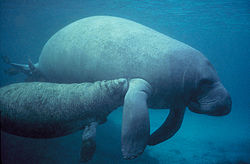This is an old revision of this page, as edited by Apostrophe (talk | contribs) at 04:28, 20 May 2006. The present address (URL) is a permanent link to this revision, which may differ significantly from the current revision.
Revision as of 04:28, 20 May 2006 by Apostrophe (talk | contribs)(diff) ← Previous revision | Latest revision (diff) | Newer revision → (diff)
| Manatee | |
|---|---|

| |
| Manatee with calf. | |
| Conservation status | |
| Vulnerable | |
| Scientific classification | |
| Kingdom: | Animalia |
| Phylum: | Chordata |
| Class: | Mammalia |
| Order: | Sirenia |
| Family: | Trichechidae Gill, 1872 |
| Genus: | Trichechus Linnaeus, 1758 |
| Species | |
|
Trichechus inunguis | |
Manatees (family Trichechidae, genus Trichechus) are large aquatic mammals sometimes known as sea cows. The Trichechidae differ from the Dugongidae in the shape of the skull and the shape of the tail. Manatees' tails are paddle-shaped, while the Dugong's are forked. They are herbivores, spending most of their time grazing in shallow waters, and can weigh anywhere from 1,000 to 2,000 pounds.
Manatees inhabit the shallow, marshy coastal areas of North, Central, and South America, and the Caribbean Sea.
Vulnerable
All three species of manatee are listed by the IUCN as Vulnerable to extinction. Although it does not have any natural predators, human expansion has reduced its natural habitat in the coastal marsh areas and many manatees are injured by the propellers of outboard motor boats. Manatees will often ingest fishing gear (hooks, metal weights, etc.) during feeding. These foreign materials do not seem to harm manatees, except for monofilament line or string. This can get clogged in the animal's digestive system and slowly kill the animal.
Manatees are killed and injured by propellers and by impacts from boat hulls. They can also be crushed in water control structures (navigation locks, flood gates, etc.), drown in pipes and culverts, and are occasionally killed due to ingestion of fishing tackle (hooks have been known to perforate the GI tract) and entanglement in fishing gear (crab pot float lines, shrimp trawls, cast nets, etc.)
Genetics
One of the closest surviving relatives of the manatee is the elephant. Manatees have many anatomical parallels with elephants, including a long, flexible nose or trunk, whiskers, and toenails.
Habitat
Manatees often congregate near power plants, which warm the waters. Some have become reliant on this source of unnatural heat and have ceased migrating to warmer waters. Some power plants have recently been closing and the U.S. Fish and Wildlife Service is trying to find a new way to heat the water for these manatees.
The main water treatment plant in Guyana has three manatees that keep storage canals clear of weeds.
References
- Shoshani, J. (2005). Wilson, D.E.; Reeder, D.M. (eds.). Mammal Species of the World: A Taxonomic and Geographic Reference (3rd ed.). Johns Hopkins University Press. p. 93. ISBN 978-0-8018-8221-0. OCLC 62265494.
External links
- Bagheera An educational website of Earth's Endangered Animals.